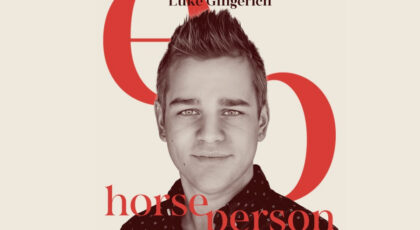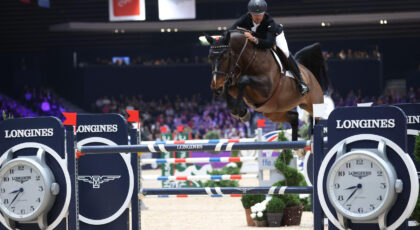We hear it time and time again: Our horses are looking for a leader, and we need to be “it” in our micro-herd of two. We do our groundwork, we’re firm yet kind, we provide our horses with the feeling of safety they require…but how do we extend this leadership to our time on the horse’s back? What does good leadership from a rider look like? In her book How Two Minds Meet: The Mental Dynamics of Dressage, Beth Baumert examines the role of leadership in our relationships with our horses, and in their under-saddle training.
***
Under saddle, horses definitely have remnants of the herd mentality.
They still need a leader, they still appreciate a sense of freedom, and they don’t mind being told where to go and how to get there by the leader. When you’re in the saddle, that’s you. You’re the leader.
Active aids and passive aids
Your aids are active when you ask a question, and they are passive when you listen and give him time to respond. Active aids establish the rider as the leader. They say, Let’s do this now! On the other hand, passive aids provide a moment of freedom for the horse and also time for the rider to listen for the horse’s reaction. The passive aids also say, Good! This is what I want! Although the passive aids do not establish you as a leader, they do make you the kind of rider the horse wants to follow.
When a rider is just learning, she will be unable to be passive, and, therefore, unable to be completely effective with her active aids because she gives so many unintentional aids. At that point, the rider’s primary focus is learning to be a passive follower. She can best acquire this ability to follow and be passive on the longe line with a horse controlled by the instructor. Later she can learn how to use active aids that come from a quiet place.
With passive aids, the rider is not only listening but also allowing her horse the freedom to physically carry himself and make the mental choice to obey her wishes. His feeling of freedom gives the outward appearance that he’s performing of his own accord. This is what makes him look beautiful on the “outside” as well as happy on the “inside.” It has been said that a great leader is one whose followers don’t feel they’re being led. Well-trained horses don’t feel subservient. They’re partners in the dance.
Trustworthy leader
Horses are usually happy when they’re ridden by a trustworthy leader. To be seen as the leader, you don’t need to be aggressive, but you do need to be able to stand your ground sometimes and establish yourself as the leader by being task-oriented. The horse knows who the leader of the dance is in the first 10 seconds. So if you get on and wander around like the lost tribes of Egypt, misaligning his neck while chatting with your friends, he is the leader and he knows this. In the absence of a leader, some horses become worried and others are happy to wander around, but don’t expect them to be tuned in to you all of a sudden when you’re done chatting.
To be seen as trustworthy, you need to be consistent, clear, kind, and fair. This doesn’t mean you spoil your horse. You can be quite challenging as a trainer and still be consistent, clear, kind, and fair. Consistency and clarity require the physical skill and ability to follow the horse precisely, then to give exactly the same aids for the same request every time. The ideal trainer expects exactly the same response to these same aids.
Even if you aren’t skilled enough yet to be even close to the ideal trainer, concentrate on the goal of being consistent, clear, kind, and fair with the intention of being successful. It will help. When you concentrate with the right intention, your horse will understand less-than-ideal aids, and both of you will improve.
There is a German word: consequent. It’s an adjective that describes the consistently clear aids from which the rider expects very precise responses as a consequence of those precise aids. With this consistent clarity, the horse understands and is obedient to your aids, you reward the horse for his positive responses, and trust is built.
Remember: You establish yourself as the trustworthy leader in the beginning of your ride, but that doesn’t mean you go right to work. When you get on, your horse needs at least 10 or 15 minutes of walking to lubricate the joints and warm up the muscles. When this walking is the daily routine, he comes to expect the relaxation and looseness it brings to the work session. The benefits of his comfortable attitude are far-reaching.

This excerpt from How Two Minds Meet: The Mental Dynamics of Dressage by Beth Baumert is reprinted with permission from Trafalgar Square Books (www.horseandriderbooks.com).




 February 23, 2021
February 23, 2021 




























